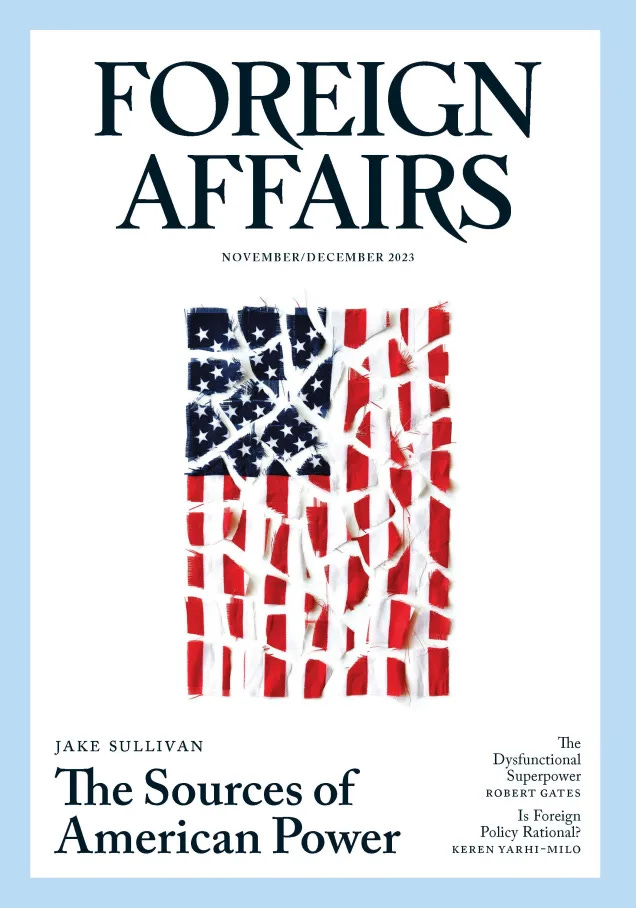The Sources of American Exhaustion
Some Thoughts on Jake Sullivan’s Spectacularly Poorly Timed Article
Greetings from New York!
I'm here for a conference at the Council on Foreign Relations, where I'll be talking about the war in Ukraine, and the geopolitics of European defense. Of course, I've barely been able to pay attention to Ukraine for the last few weeks, as my other regional interest - the Middle East - has exploded back to prominence in the news. I'm spending a lot of my time talking about the regional petrostates - Saudi Arabia, Qatar, Iran - that are the central characters of my book, all while frantically trying to keep up with developments in Europe, and feeling like I can't quite find the time for longer term strategic writing projects. So I'm pretty sure I have an intuitive feeling for how the foreign policy folks at the top of the Biden administration feel at the moment.
With that in mind, I have a few Friday morning thoughts on “The Sources of American Power,” an article published by National Security Advisor Jake Sullivan earlier this week in Foreign Affairs. Lots of folks have focused on the big gotcha in the article, which was clearly sent to print before Hamas’ brutal October 7th attacks on Israel, and which includes the memorable pull-quote “the Middle East is quieter than it has been for decades.”
But I think the article is actually more notable for what it tells us about the Biden administration’s strategy strategy more broadly. As you might expect from Sullivan, it's a very clear, well-stated representation of how the administration thinks about foreign policy. It's also deeply problematic in practice. Here are my general impressions:
The article is a fairly consistent representation of what the administration has emphasized in foreign policy: a heavy focus on economic statecraft, concerns about domestic-foreign policy linkages, and a strong emphasis on alliance-building. It talks less about maintaining US military primacy, though that’s clearly still a central component of the Biden policy agenda. The piece foregrounds an economic policy agenda, which is consistent with the administration’s past statements, and its focus on coercive economic statecraft and industrial policy designed to undermine key competitors. There's not time here to delve into the full implications of that agenda, but I remain unconvinced that sharpening and expanding the use of American economic power globally will produce a more open or liberal global economic system. Sullivan’s assertion that this isn’t protectionism continues to ring somewhat hollow.
There's a very clear sense in the piece that Sullivan - and likely others in the administration - see their role as analogous to that played by thinkers in the 1940s and 1950s, whose choices about strategy ultimately put US foreign policy on a path that would last decades. Even the title evokes that period, though it was undoubtedly picked by the editors rather than by Sullivan himself. It is notable, though, that while Kennan’s X article sought to explain the sources of Soviet Conduct, Sullivan is instead talking primarily about how America wants to shape the world. There's no clear framing of threats the United States faces, or particular attention to the perspectives of other states. It’s very US-centric.
Particularly striking in the context of that 1950s comparison is how little genuine change is proposed in this document. Whatever else we might say about the policy debates that characterized US foreign policy in the 1940s and 1950s, one cannot deny that in responding to a changed world, they made significant shifts in US policy. Instead, the Biden administration's approach to alliances has always reminded me a bit of a tacky 1990s fridge magnet. “Make new friends, but keep the old; one is silver and the other is gold” might be a good slogan for cards at the Hallmark store, but it's not a great way to run a foreign policy. Sullivan argues that the US is updating and reforming alliances to match 21st century needs, but the process he describes is just doubling down on existing commitments, while adding new ones.
I often hesitate to draw on public opinion polling for foreign policy, because I tend to think it's as much driven by elite cues as anything else. But that’s not always the case, and it’s notable how out-of-touch Sullivan 's article is with much of the recent polling on US foreign policy. This is most visible in his assertion that the American approach to Ukraine is sustainable, that American support for Ukraine is broad and that it will endure. Instead, polling now shows a majority of Americans opposed to significant further Ukraine aid. A recent poll from my friends over at the Eurasia Group Foundation found that a majority of Americans want to negotiate an end to the war, and even among Democrats, the number that think Ukraine aid is too high has tripled since the start of the war.
The public support problem is not the only reason to question the fundamental basis of Sullivan's argument. He actually concedes in this document that the liberal order is largely ephemeral — or at least that it is real, with real benefits, but heavily dependent on US power to sustain it. As he puts it:
“The post–Cold War era was a period of great change, but the common thread throughout the 1990s and the years after 9/11 was the absence of intense great-power competition. This was mainly the result of the United States’ military and economic preeminence, although it was widely interpreted as evidence that the world agreed on the basic direction of the international order.”
This contradicts much of the administration’s rhetoric. It also suggests genuine concern is warranted about whether the relatively open liberal order can survive in the absence of US power. The US faces genuine questions about resource constraints, something Sullivan himself acknowledges when he argues that the withdrawal from Afghanistan has helped to free up resources for Ukraine. Is US power sufficient for what Sullivan and Biden hope to do in the world? I don’t know, and neither do they. It’s a huge bet, with significant downside risk.
All of this brings me back to the article’s Middle East gaffe. This is the second time that the administration has been overtaken by events in this way; many of you may recall that the National Security Strategy had to be redrafted after the Russian invasion of Ukraine, at least in part to re-emphasize Russia as a threat. This highlights a big problem with the administration’s approach to the world: they clearly recognize that there are trade-offs, and accept that some regions are less important than others. But they are unwilling to actually take the steps to deprioritize those regions. Even after the initial crisis, they have failed to push more strongly for European burden-sharing, both on Ukraine aid and on European defense more broadly, a huge wasted opportunity. They clearly failed in their attempts to build a more sustainable Middle Eastern order by subordinating the Palestinian problem to an anti-Iran and anti-China approach. In short, when a crisis arises anywhere, the administration rushes back, drawn by their inability to accept the consequences of deprioritizing certain regions.
The end result is overstretch and the de prioritization of anything that isn’t an immediate crisis. I wrote an article for Defense News earlier this week talking about the administration’s budget supplemental request, which also exemplifies this problem:
“Perhaps the biggest problem here is the increasingly grandiose and global nature of the Biden administration’s approach to national security. Bundling together Israel, Ukraine, the border and even Taiwan in the budget supplemental may reinforce the arguments Biden made in his speech: that “there is nothing, nothing beyond our capacity,” and that America is the “essential nation.”
But the actual breakdown of the supplemental request shows the reality: the United States does face trade-offs in foreign policy. In prioritizing conflicts in Europe and the Middle East, Biden is in practice deprioritizing the Indo-Pacific, perhaps the region with the most genuinely pressing security threats for the United States itself. Congress would be wise to consider whether the breakdown of this supplemental spending bill is really the most efficient and strategic use of America’s limited resources.”
Is there a way to make the Biden administration’s ambitious global approach sustainable? Whether you look at public opinion or at spending - where the deficit doubled in the last year - or even at the overstretched state of the defense industrial base, I think you have to question that. A good strategy would address this problem head-on, considering the trade-offs or sacrifices that might need to be made in order to achieve sustainability. Instead, this article just reminds us that the Biden administration has largely chosen to ignore potential constraints, building up economic tools, and doing little to put American foreign policy on a strategically sustainable footing.






This was good. Thank you for sharing. I’d be curious sometime to have you talk about how you would do things if you were in charge.
There will never be a pivot to Asia! US FP elite cares about ME and Europe, there is no emotional juice in Asia.